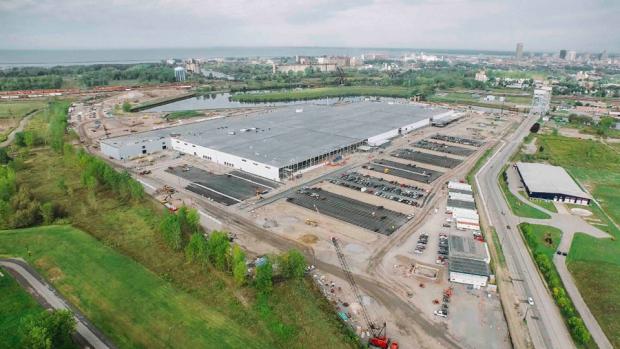How Sprawl Undermines Buffalo’s Momentum
As of Super Tuesday 2016, cumbersome Albany payment systems were still causing construction delays in the Solar City factory rising on the south bank of the Buffalo River. That factory and its associated activities promise a couple of thousand new manufacturing jobs to arrive in the Buffalo-Niagara Falls metro, replacing the couple of thousand old manufacturing jobs that were lost over the past decade. In a metro area with more than 18,000 of about 36,000 African-American men are not participating in the workforce, and with an absolute reduction in the overall workforce size still underway, new manufacturing jobs for a growth industry are very good news.
And make no mistake about the economics of the solar panels and the associated lithium batteries that Solar City CEO Elon Musk will be producing: New research published by Bloomberg News, building on peer-reviewed research by Stanford’s Mark Jacobson et alia, demonstrate that the potential uptake of new alternative-energy inputs graphs out looking more like a hockey stick, or at least an S-curve, than just a nice slow increase. In other words, electric cars (for example), which are now less than one percent of the total car market, will, within five to 10 years, suddenly ramp up very fast to tens of millions of vehicles—and soon after could utterly supplant gas-powered cars. Kind of like the way we took to cell phones. Ditto solar panels knocking out home heating and electrical generation currently powered by burning fossil fuels.
So the place, the actual central-city location, where the new virtuous cycle of technology, high skill, new construction, and high wages will all happen, that’s the place that will reap the economic benefits—right?
Not so fast, say the data.
Another new report on poverty
The very day last week that we were inventorying the housing stock, household incomes, and Earned Income Tax Credit eligibility of the West Side of Buffalo turned out to be release day for Economic Innovation Group’s Distressed Communities Index.
Buffalo wasn’t number one on that list. We are behind Cleveland, Detroit, Toledo, Newark, a couple of bankrupt California cities, and Milwaukee (which still tops the list of out-of-workforce African-American men aged 20-64). Buffalo is way down at number eight on the list of 100 most distressed areas, with over 60 percent of folks here living in distressed areas.
There’s nothing new in that, actually, and we’re understandably fatigued with social scientists counting our poor noses within the boundaries of the City of Buffalo, as if there were a wall running across Kenmore Avenue to Bailey and down to the start of McKinley Parkway.
The true utility of this report lies in its overall conclusion: that the Obama economic recovery, which really has produced 14 million new jobs since 2008, and which really has produced around 30,000 new jobs in the Buffalo-Niagara Falls metro area, has happened in this context:
- ongoing concentration of low-income households in old urban centers;
- ongoing suburban sprawl;
- comparatively few of the new jobs being above the median wage for most Zip Codes; and
- low-wage work, remaining the norm in old urban centers.
In short, except for the couple of hundred high-wage jobs related to banking, some construction work for Solar City and the Medical Campus, the Obama recovery here looks like it does everywhere else in America: good to have, welcome news, but still leaving many urban American spaces with the legacy of 60 years of outward drift of population, enterprises, housing, and skills.
And as we showed here recently, by tracking the 60,000 construction permits issued since 1980 for single-family dwellings, only 1,200 of the total were issued inside the boundaries of Buffalo and Niagara Falls.
The new jobs and new money are being poured into a sieve.
Hopeful signs?
Sprawl happened, it’s still happening, and just now, there’s nothing in the way of policy, regulation, or law that is changing the dynamic of young families departing the centers of any of the cities on the Distressed Communities Index for the suburban peripheries of Cleveland, Detroit, Toledo, Cincinnati, Newark, or Buffalo. Milwaukee has had some notable success in retaining population, according to former Mayor John Norquist, because of a robust school-choice program—but Milwaukee is the worst in workforce participation for the most marginalized minorities, and has a home-grown white supremacist movement, a home-grown black supremacist movement, ills that nobody seeks to replicate.
But we remain hopeful that immigrants to Buffalo will find the observable phenomenon of housing-value appreciation on the West Side attractive enough to prevent further outmigration—in the decades-old pattern pioneered by World War II’s refugees—to the first- and second-ring suburbs.
We recently noted that Syracuse, another distressed municipality, is engaged in a conversation about restructuring its governance such that sprawl is contained and the positive phenomenon of “the great inversion,” as Alan Ehrenhalt calls it, happens there in the form of durable re-population of the city.
As one travels West Side streets and sees handsome, sturdy, well-built (albeit lead-paint-coated) two-story houses, one can only hope that the generations of subsidies for sprawl will end, and that the bankers who financed Buffalo’s abandonment can be cajoled into profiting by refinancing the cityscape that will continue to erode without their involvement.
Bruce Fisher is visiting professor at SUNY Buffalo State and director of the Center for Economic and Policy Studies.

